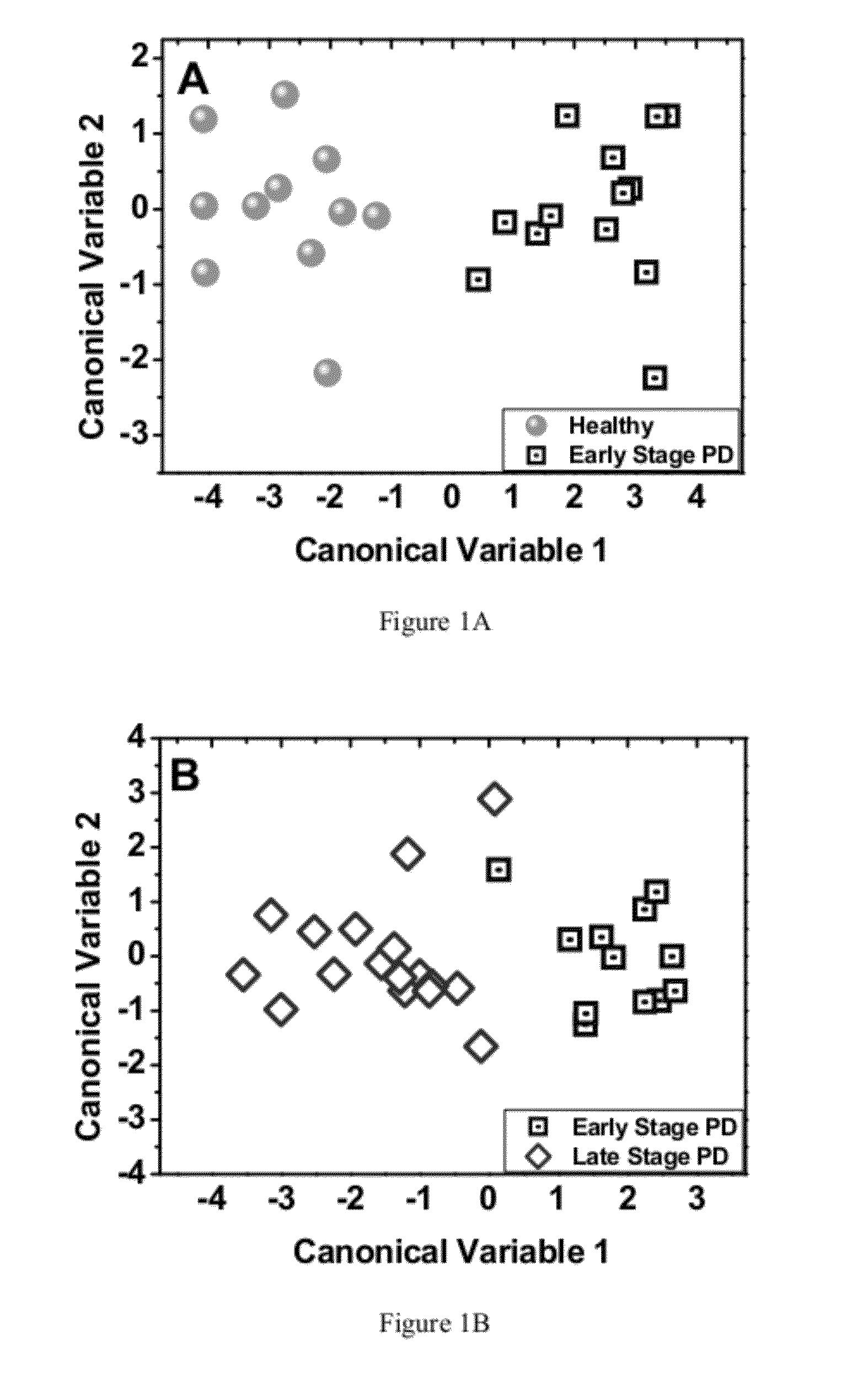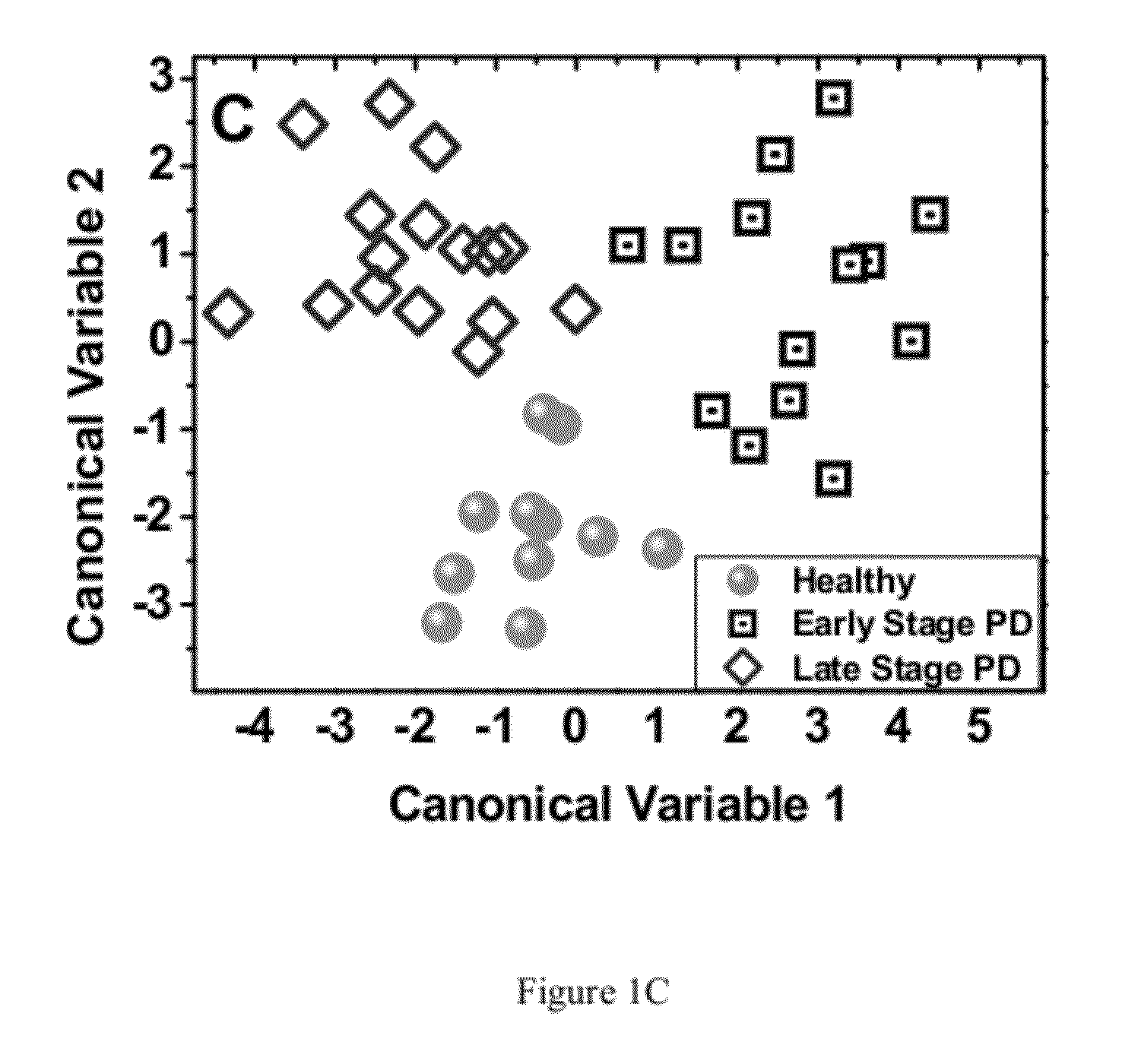Method of diagnosing, prognosing and monitoring parkinson's disease
a parkinson's disease and breath technology, applied in chemical machine learning, instruments, applications, etc., can solve the problems of inconvenient and time-consuming laboratory procedures, no simple and reliable technique is available for the early diagnosis of pd, and blood sampling is invasiv
- Summary
- Abstract
- Description
- Claims
- Application Information
AI Technical Summary
Benefits of technology
Problems solved by technology
Method used
Image
Examples
example 1
Test Population
[0092]The test population included 41 non-smoking volunteers (30 PD patients and 11 healthy controls) at the ages of 37-82. All volunteers were recruited from the out-patient population of the Department of Neurology and the Cognitive Unit, Rambam Health Care Campus (Haifa, Israel), and their accompanying persons. The PD patients were diagnosed in a specialist setting and staged according to the modified Hoen and Yahr (HY) scale (Hoehn et al., Neurology, 1967, 17, 427-442; Goetz et al., Mov. Disord., 2004, 19, 1020-1028). All PD patients were medicated (L-Dopa±agonists). A summary of the patient characteristics is provided in Table 1A and the full clinical details are provided in Table 1B.
TABLE 1ASummary of the clinical characteristics of 41 non-smoking subjects that were tested in this studyModifiedNumberAverageMale:HY(1)of testedAge + / −FemalestageStage Description(2)personssensorsGC-MSSTDratioEarly1Unilateral313132258 ± 97:6stageinvolvement onlyPD1.5Unilateral and a...
example 2
[0094]The clinical study was cross-sectional. Highly accurate diagnosis was achieved through clinical examination in a specialist setting. The clinical diagnosis was used as a reference standard. The tested PD patients were divided into two groups, namely early stage and advanced stage PD. These two patient groups were compared with healthy controls. 13 PD patients that were classified as stages 1, 2 and 2.5 on the modified Hoehn and Yahr scale were grouped as early stage PD patients, and 17 patients that were classified as stages 3 and 4 were grouped as advanced stage PD patients. Signal patterns of the three test groups were obtained using the system of the present invention as follows: (i) early stage PD patients were compared to healthy controls, (ii) advanced stage PD patients were compared to early stage PD patients, and (iii) all three test groups (early stage PD, advanced stage PD and healthy controls) were analyzed together. No patient exclusion criteria were ...
example 3
Breath Collection
[0095]Exhaled alveolar breath was collected in a controlled manner from PD patients and from healthy controls in the hospital environment. The inhaled air was cleared of ambient contaminants by repeatedly inhaling to total lung capacity for 3-5 minutes through a mouthpiece (purchased from Eco Medics, Duerten, Switzerland) that contained a filter cartridge on the inspiratory port, thus greatly reducing the concentration of exogenous volatile organic compounds and removing 99.99% of the exogenous compounds from the air during inspiration. The unfiltered hospital air was sampled for typical hospital contaminations (Amann et al., Euro. Resp. Soc. Monograph, 2010, 49, 96). The following typical hospital contaminants: 2-methyl-2-propanol, ethanol and methyl-isobutyl-ketone, were detected using GC-MS in conjugation with Solid-Phase Micro-Extraction (SPME). Trace amounts of these compounds were identified in less than 23% of the study population, indicating that the air fil...
PUM
 Login to View More
Login to View More Abstract
Description
Claims
Application Information
 Login to View More
Login to View More - R&D
- Intellectual Property
- Life Sciences
- Materials
- Tech Scout
- Unparalleled Data Quality
- Higher Quality Content
- 60% Fewer Hallucinations
Browse by: Latest US Patents, China's latest patents, Technical Efficacy Thesaurus, Application Domain, Technology Topic, Popular Technical Reports.
© 2025 PatSnap. All rights reserved.Legal|Privacy policy|Modern Slavery Act Transparency Statement|Sitemap|About US| Contact US: help@patsnap.com



